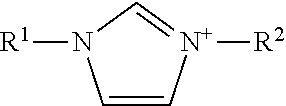Method of treating plant biomass
a plant biomass and treatment method technology, applied in biofuels, waste based fuels, fermentation, etc., can solve the problems of affecting the quality of plant biomass, and affecting the production efficiency of plant biomass, so as to achieve efficient saccharification and increase the saccharification efficiency
- Summary
- Abstract
- Description
- Claims
- Application Information
AI Technical Summary
Benefits of technology
Problems solved by technology
Method used
Image
Examples
Embodiment Construction
The Plant Biomass Treatment Method
[0018]An exemplary embodiment of the invention relates to a method of treating plant biomass including immersing plant biomass in a solution that contains a polar solvent and an imidazolium salt that has a melting point of at least 100° C. In this Specification, “treatment of plant biomass” denotes the relaxation of the cellulose and / or hemicellulose present in a plant biomass. “Relaxation of the cellulose and / or hemicellulose” denotes the depolymerization or decrystallization of cellulose and / or hemicellulose and particularly crystalline cellulose.
[0019]That is, when plant biomass is immersed in a solution including a polar solvent and an imidazolium salt that has a melting point of at least 100° C. (this solution is also referred to below as the “treatment solution”), the cellulose and hemicellulose present in the plant biomass undergo relaxation and become more readily accessible to cellulase-mediated degradation. Depending on the circumstances, ...
PUM
| Property | Measurement | Unit |
|---|---|---|
| melting point | aaaaa | aaaaa |
| temperature | aaaaa | aaaaa |
| temperature | aaaaa | aaaaa |
Abstract
Description
Claims
Application Information
 Login to View More
Login to View More - R&D
- Intellectual Property
- Life Sciences
- Materials
- Tech Scout
- Unparalleled Data Quality
- Higher Quality Content
- 60% Fewer Hallucinations
Browse by: Latest US Patents, China's latest patents, Technical Efficacy Thesaurus, Application Domain, Technology Topic, Popular Technical Reports.
© 2025 PatSnap. All rights reserved.Legal|Privacy policy|Modern Slavery Act Transparency Statement|Sitemap|About US| Contact US: help@patsnap.com



